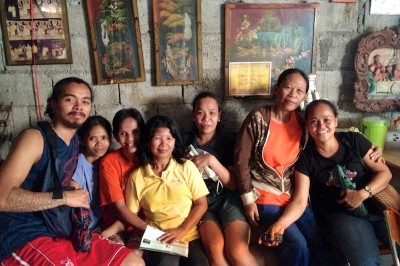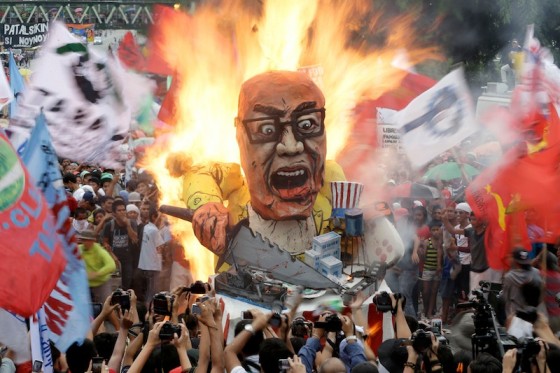Why I spent the last week building a giant effigy of the president of the Philippines.
For those that witnessed the 1999 WTO protest in Seattle, or the NATO protest I attended in Chicago last year, it was a familiar sight.
In Manila, more than 20,000 Filipinos and international allies joined the mobilization led by BAYAN, a massive umbrella organization for leftists groups in the Philippines, on July 22nd to protest the president’s State of Union Address (SONA).
President Benigno Aquino III, named by Time Magazine as one of the most 100 influential people of the world, was expected to brag in his speech about the Philippines’ 7.8 percent economic growth.
The country has the fastest growing economy in Asia. But critics argue that that growth has only benefited a wealthy few tied to local and multinational corporations, and does not trickle down to the vast majority of the country.
Every year since 1999, a group called UGATLahi Artist Collective has constructed effigies for SONA. Constructed with bamboo and paper mache, this year’s effigy was a 13-foot statue of Aquino seated at a dinner table, to symbolize how he and his friends are gorging themselves with profits. In the effigy he was surround by privatized hospitals and trains, and American warships used to protect corporate interests

“The people are not invited to this exclusive dinner party by the ruling elite.” said Cris de Leon UGATLahi cultural worker and head artist of the effigy. “Look who’s pigging out while the rest of the nation is starving.”
Aquino’s troublesome economic policies include the ramping up exports of natural resources, privatization of social services such as hospitals, water, and transportation, and private land development that has led to the demotion of thousands of homes of urban poor families.
Everyday Filipinos are being hit with rising costs and joblessness that impacts over 7.2 million people, and according to the National Statistics Office, the gap between the rich and the poor is wider than years past.
Like the WTO protests in Seattle in 1999, the Occupy movement and the protests across Brazil in recent weeks, Monday’s demonstration echoed the sentiment that governments serving the profit of large multinational corporations will be met with resistance and rejection from people.
Manila police turned violent on the crowds of unarmed civilians, many of whom were bludgeoned on the head with truncheons. So far, Aquino has not denounced the use of violence against the protesters.
Police and protestors standoff at the 2013 SONA demonstrations (skip to 3:00 for police attack).
At the demonstration there were hundreds of international solidarity delegates from places like Canada, Australia, Netherlands, Japan, and the U.S. who were in town to attend the International Conference for Human Rights and Peace in the Philippines. They had also come to support the Filipino activists and also call to their countries to put the needs of their people first over profit.
“My problems are the same as everyone else’s. [Activism] has answered that isolation and disconnect I felt when I wasn’t organized,” says de Leon. “Art has become not just about reflecting on what’s really going on, but becoming of the solution. I am humbled and happy to participate. I share this struggle with the workers, the farmers, and the masses.”
The effigy I worked on with de Leon took eight days and sleepless nights to build.
It burned in less than 8 minutes.
But it sent a strong message to the Aquino Administration that the Filipino people will not go gently in their struggle, that they will fight until the the needs of the people are met and that there is genuine democracy for everyone.


